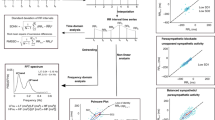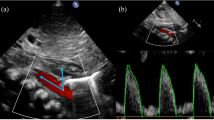Abstract
Objective:
Brain injury in preterm infants may lead to an inflammatory response and central nervous system dysfunction reflected by abnormal heart rate characteristics (HRC). We hypothesized that a continuously monitored HRC index reflecting reduced HR variability and decelerations correlates with abnormal neuroimaging and outcomes in extremely low birth weight infants (ELBW).
Study Design:
We analyzed the average HRC index within 28 days after birth (aHRC28) and head ultrasound (HUS) in 384 ELBW infants. In 50 infants with brain magnetic resonance imaging (MRI) and 70 infants with Bayley neurodevelopmental testing at 1 year of age, we analyzed the relationship between aHRC28, MRI abnormalities and low Bayley scores.
Result:
aHRC28 was higher in infants with severe HUS abnormalities (2.65±1.27 for Grade III-IV intraventricular hemorrhage (IVH) or cystic periventricular leukomalacia (cPVL) versus 1.72±0.95 for normal or Grade I-II IVH, P<0.001). Higher aHRC28 was also associated with white matter damage on MRI and death or Bayley motor or mental developmental index <70. Associations persisted after adjusting for gestational age, birth weight and septicemia. For every one point increase in aHRC28, the odds ratio of death or Bayley score <70 was 2.45 (95% CI 1.46, 4.05, P<0.001).
Conclusion:
A continuously monitored HRC index provides an objective, noninvasive measure associated with abnormal brain imaging and adverse neurologic outcomes in ELBW infants.
This is a preview of subscription content, access via your institution
Access options
Subscribe to this journal
Receive 12 print issues and online access
$259.00 per year
only $21.58 per issue
Buy this article
- Purchase on Springer Link
- Instant access to full article PDF
Prices may be subject to local taxes which are calculated during checkout




Similar content being viewed by others
References
Stoll BJ, Hansen NI, Bell EF, Shankaran S, Laptook AR, Walsh MC et al. Neonatal outcomes of extremely preterm infants from the NICHD Neonatal Research Network. Pediatrics 2010; 126 (3): 443–456.
Rees S, Harding R, Walker D . The biological basis of injury and neuroprotection in the fetal and neonatal brain. Int J Dev Neurosci 2011; 29 (6): 551–563.
Rees S, Inder T . Fetal and neonatal origins of altered brain development. Early Hum Dev 2005; 81 (9): 753–761.
Volpe JJ . Perinatal brain injury: from pathogenesis to neuroprotection. Ment Retard Dev Disabil Res Rev 2001; 7 (1): 56–64.
Bauer SC, Msall ME . Optimizing neurodevelopmental outcomes after prematurity: lessons in neuroprotection and early intervention. Minerva Pediatr 2010; 62 (5): 485–497.
Hintz SR, Slovis T, Bulas D, Van Meurs KP, Perritt R, Stevenson DK et al. Interobserver reliability and accuracy of cranial ultrasound scanning interpretation in premature infants. J Pediatr 2007; 150 (6): 592–596 6 e1-5.
O'Shea TM, Volberg F, Dillard RG . Reliability of interpretation of cranial ultrasound examinations of very low-birthweight neonates. Dev Med Child Neurol 1993; 35 (2): 97–101.
Mathur AM, Neil JJ, Inder TE . Understanding brain injury and neurodevelopmental disabilities in the preterm infant: the evolving role of advanced magnetic resonance imaging. Semin Perinatol 2010; 34 (1): 57–66.
Klebermass K, Olischar M, Waldhoer T, Fuiko R, Pollak A, Weninger M . Amplitude-integrated EEG pattern predicts further outcome in preterm infants. Pediatr Res 2011; 70 (1): 102–108.
Cao H, Lake DE, Ferguson JE 2nd, Chisholm CA, Griffin MP, Moorman JR . Toward quantitative fetal heart rate monitoring. IEEE Trans Biomed Eng 2006; 53 (1): 111–118.
Griffin MP, O'Shea TM, Bissonette EA, Harrell FE Jr., Lake DE, Moorman JR . Abnormal heart rate characteristics preceding neonatal sepsis and sepsis-like illness. Pediatr Res 2003; 53 (6): 920–926.
Moorman JR, Lake DE, Griffin MP . Heart rate characteristics monitoring for neonatal sepsis. IEEE Trans Biomed Eng 2006; 53 (1): 126–132.
Griffin MP, Lake DE, Bissonette EA, Harrell FE Jr., O'Shea TM, Moorman JR . Heart rate characteristics: novel physiomarkers to predict neonatal infection and death. Pediatrics 2005; 116 (5): 1070–1074.
Fairchild KD, O'Shea TM . Heart rate characteristics: physiomarkers for detection of late-onset neonatal sepsis. Clin Perinatol 2010; 37 (3): 581–598.
Biswas AK, Scott WA, Sommerauer JF, Luckett PM . Heart rate variability after acute traumatic brain injury in children. Crit Care Med 2000; 28 (12): 3907–3912.
Goldstein B, Toweill D, Lai S, Sonnenthal K, Kimberly B . Uncoupling of the autonomic and cardiovascular systems in acute brain injury. Am J Physiol 1998; 275 (4 Pt 2): R1287–R1292.
Woodward LJ, Anderson PJ, Austin NC, Howard K, Inder TE . Neonatal MRI to predict neurodevelopmental outcomes in preterm infants. N Engl J Med 2006; 355 (7): 685–694.
Cao H, Lake DE, Griffin MP, Moorman JR . Increased nonstationarity of neonatal heart rate before the clinical diagnosis of sepsis. Ann Biomed Eng 2004; 32 (2): 233–244.
Moorman JR, Rusin CE, Lee H, Guin LE, Clark MT, Delos JB et al. Predictive monitoring for early detection of subacute potentially catastrophic illnesses in critical care. Conf Proc IEEE Eng Med Biol Soc 2011; 2011: 5515–5518.
Kovatchev BP, Farhy LS, Cao H, Griffin MP, Lake DE, Moorman JR . Sample asymmetry analysis of heart rate characteristics with application to neonatal sepsis and systemic inflammatory response syndrome. Pediatr Res 2003; 54 (6): 892–898.
Lake DE, Richman JS, Griffin MP, Moorman JR . Sample entropy analysis of neonatal heart rate variability. Am J Physiol Regul Integr Comp Physiol 2002; 283 (3): R789–R797.
Gujjar AR, Sathyaprabha TN, Nagaraja D, Thennarasu K, Pradhan N . Heart rate variability and outcome in acute severe stroke: role of power spectral analysis. Neurocrit Care 2004; 1 (3): 347–353.
Kox M, Vrouwenvelder MQ, Pompe JC, van der Hoeven JG, Pickkers P, Hoedemaekers CW . The effects of brain injury on heart rate variability and the innate immune response in critically ill patients. J Neurotrauma 2012; 29 (5): 747–755.
Eventov-Friedman S, Shinwell ES, Barnea E, Flidel-Rimon O, Juster-Reicher A, Levy R . Correlation between fetal heart rate reactivity and mortality and severe neurological morbidity in extremely low birth weight infants. J Matern Fetal Neonatal Med 2012; 25 (6): 654–655.
Tuzcu V, Nas S, Ulusar U, Ugur A, Kaiser JR . Altered heart rhythm dynamics in very low birth weight infants with impending intraventricular hemorrhage. Pediatrics 2009; 123 (3): 810–815.
Hanna BD, Nelson MN, White-Traut RC, Silvestri JM, Vasan U, Rey PM et al. Heart rate variability in preterm brain-injured and very-low-birth-weight infants. Biol Neonate 2000; 77 (3): 147–155.
Addison K, Griffin MP, Moorman JR, Lake DE, O'Shea TM . Heart rate characteristics and neurodevelopmental outcome in very low birth weight infants. J Perinatol 2009; 29 (11): 750–756.
Acknowledgements
We thank Jodi Darring for her work on data collection for this study. This work is supported by NICHD 051609 (KDF), NIGMS 064640 (JRM), NICHD 058672 (JB), and the University of Virginia Children’s Hospital.
Author information
Authors and Affiliations
Corresponding author
Ethics declarations
Competing interests
The heart rate characteristics monitoring randomized clinical trial was supported by NIH (grant R01-HD48562 to J.M.) and by Medical Predictive Science Corporation, Charlottesville, VA, which provided study hardware and software for heart rate characteristics monitoring and for study data collection and management. Neither of these funding sources had any role in the design of the original study or the current report, in the analysis and interpretation of the data, in the decision to submit the manuscript, or in the preparation, review, or approval of it. Dr Lake and Dr Moorman have consulting agreements and equity shares in Medical Predictive Science Corporation, Charlottesville, VA.
Rights and permissions
About this article
Cite this article
Fairchild, K., Sinkin, R., Davalian, F. et al. Abnormal heart rate characteristics are associated with abnormal neuroimaging and outcomes in extremely low birth weight infants. J Perinatol 34, 375–379 (2014). https://doi.org/10.1038/jp.2014.18
Received:
Revised:
Accepted:
Published:
Issue Date:
DOI: https://doi.org/10.1038/jp.2014.18
Keywords
This article is cited by
-
Sample entropy correlates with intraventricular hemorrhage and mortality in premature infants early in life
Pediatric Research (2024)
-
Heart rate patterns predicting cerebral palsy in preterm infants
Pediatric Research (2023)
-
Omics approaches: interactions at the maternal–fetal interface and origins of child health and disease
Pediatric Research (2023)
-
Vital signs as physiomarkers of neonatal sepsis
Pediatric Research (2022)
-
Autism risk in neonatal intensive care unit patients associated with novel heart rate patterns
Pediatric Research (2021)



